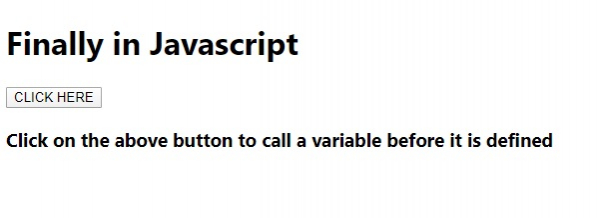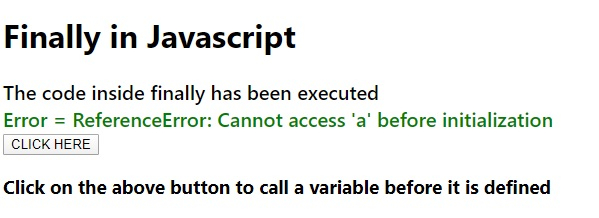
 Data Structure
Data Structure Networking
Networking RDBMS
RDBMS Operating System
Operating System Java
Java MS Excel
MS Excel iOS
iOS HTML
HTML CSS
CSS Android
Android Python
Python C Programming
C Programming C++
C++ C#
C# MongoDB
MongoDB MySQL
MySQL Javascript
Javascript PHP
PHP
- Selected Reading
- UPSC IAS Exams Notes
- Developer's Best Practices
- Questions and Answers
- Effective Resume Writing
- HR Interview Questions
- Computer Glossary
- Who is Who
Explain the finally Statement in JavaScript with examples.
The finally statement always executes after try and catch block regardless of if there was an error or not.
Following is the code for the finally statement in JavaScript −
Example
<!DOCTYPE html>
<html lang="en">
<head>
<meta charset="UTF-8" />
<meta name="viewport" content="width=device-width, initial-scale=1.0" />
<title>Document</title>
<style>
body {
font-family: "Segoe UI", Tahoma, Geneva, Verdana, sans-serif;
}
.result,.sample {
font-size: 20px;
font-weight: 500;
}
</style>
</head>
<body>
<h1>Finally in Javascript</h1>
<div class="sample"></div>
<div style="color: green;" class="result"></div>
<button class="Btn">CLICK HERE</button>
<h3>
Click on the above button to call a variable before it is defined
</h3>
<script>
let sampleEle = document.querySelector(".sample");
let resEle = document.querySelector(".result");
document.querySelector(".Btn").addEventListener("click", () => {
try {
resEle.innerHTML = a;
}
catch (err) {
resEle.innerHTML = "Error = " + err;
}
finally {
sampleEle.innerHTML = "The code inside finally has been executed";
}
let a = 44;
});
</script>
</body>
</html>
Output
The above code will produce the following output −

On clicking the ‘CLICK HERE’ button −


Advertisements
